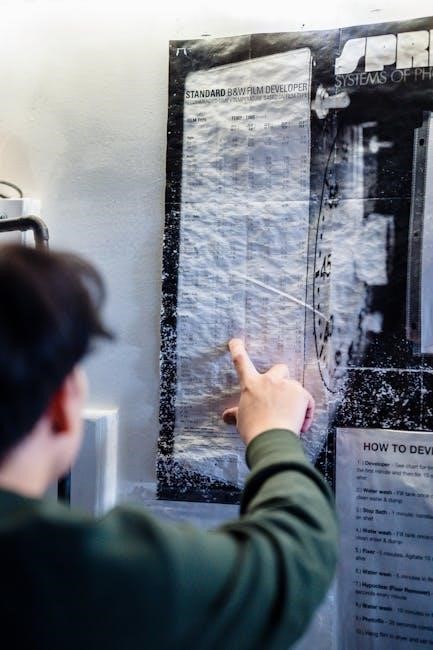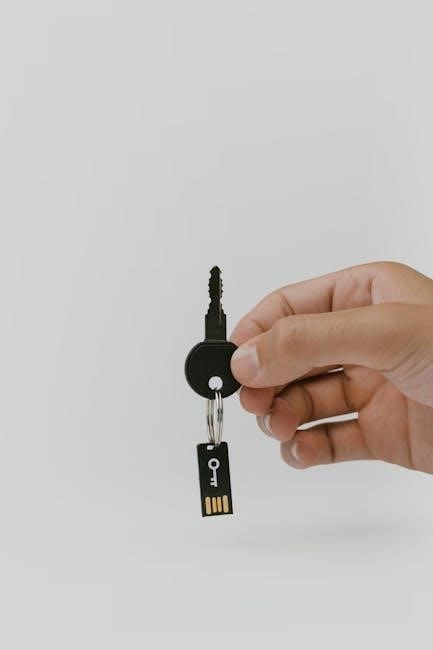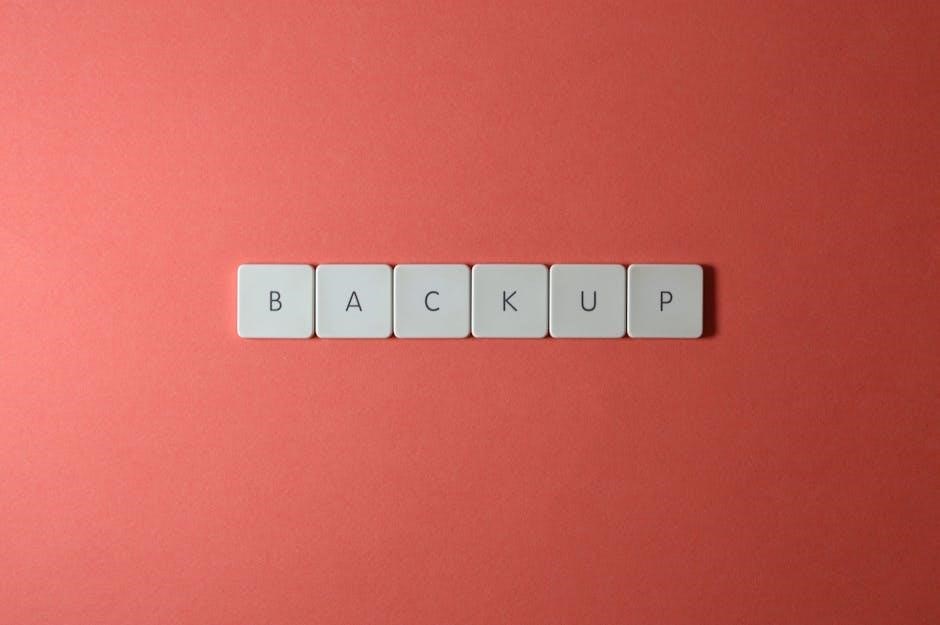
A Safety Data Sheet (SDS) is a comprehensive guide providing essential information about hazardous chemicals․ It ensures safe handling‚ use‚ storage‚ and disposal of substances like CLN 355․
Overview of SDS Importance
A Safety Data Sheet (SDS) is a critical document providing detailed information about a chemical product‚ ensuring safe handling‚ use‚ storage‚ and disposal․ It serves as a key resource for employers‚ workers‚ and emergency responders to understand potential hazards and necessary precautions․ The SDS for CLN 355 outlines its properties‚ risks‚ and safety measures‚ promoting compliance with regulatory requirements․ By adhering to the guidelines in the SDS‚ users can minimize risks to human health and the environment․ It is an essential tool for maintaining a safe workplace and ensuring proper emergency response․ The SDS is a cornerstone of chemical safety management‚ offering clear and accessible information for all stakeholders․
Structure and Sections of an SDS
A Safety Data Sheet (SDS) is a standardized document divided into 16 sections‚ providing detailed information about a chemical product․ Section 1 covers product identification‚ while Section 2 outlines hazard classifications․ Sections 3 and 4 focus on composition and first aid measures‚ respectively․ Firefighting procedures are detailed in Section 5‚ and accidental release measures in Section 6․ Sections 7 and 8 address handling‚ storage‚ and exposure controls․ Physical and chemical properties are in Section 9‚ while Sections 10 and 11 cover stability and toxicology․ Ecology and disposal are covered in Sections 12 and 13‚ with transport and regulatory information in Sections 14 and 15․ Section 16 provides additional information․ This structured format ensures clarity and accessibility for safe chemical management․

Product Identification
Product identifier: CLN 355․ Includes manufacturer/supplier details and emergency contact information for safe handling․ This section ensures proper identification and urgent assistance when needed․
Product Identifier: CLN 355
The product identifier for CLN 355 serves as a unique code assigned to this specific chemical product․ It is essential for identifying the substance and ensuring proper handling․ This identifier is prominently displayed on the product label and referenced throughout the Safety Data Sheet (SDS)․ The product identifier is crucial for quickly locating safety information in emergency situations‚ such as spills or exposure․ It also helps in verifying the product’s composition and ensuring compliance with regulatory requirements․ Additionally‚ the identifier plays a key role in inventory management and tracking within industrial settings․ By standardizing identification‚ it enhances communication across supply chains and ensures accurate safety measures are implemented․ This system is vital for maintaining workplace safety and environmental protection․
Manufacturer/Supplier Information
The manufacturer or supplier of CLN 355 is clearly identified in the SDS to provide accountability and a point of contact for safety inquiries․ This section includes the company name‚ address‚ and telephone number․ It ensures users can reach out for technical support or additional safety information․ The manufacturer’s details are essential for traceability and compliance with regulatory standards․ This information is also critical in emergency situations‚ allowing for quick communication․ The SDS for CLN 355 specifies the manufacturer as Elma‚ with their address and contact number provided for direct inquiries․ The document also includes the print date and revision date‚ ensuring the information is current and reliable for safe handling practices․
Emergency Contact Details
The SDS for CLN 355 provides emergency contact details to ensure immediate assistance in case of incidents․ This section includes phone numbers and addresses for emergency services‚ poison control centers‚ and the manufacturer’s support team․ Users can quickly access help for spills‚ exposure‚ or other incidents․ The primary emergency contact is listed as Emergency Phone: (800) 424-9300‚ available 24/7․ Additionally‚ local authorities and healthcare providers are recommended for further support․ This information ensures timely response and proper handling of emergencies‚ minimizing risks to people and the environment․ The SDS emphasizes the importance of having these contacts readily available at all times․

Hazard Identification
The SDS for CLN 355 identifies hazards through GHS classifications‚ pictograms‚ and statements․ It highlights flammability (GHS02) and eye irritation (H319)‚ ensuring awareness of potential risks․ Precautions are emphasized․
Hazard Classifications
The Safety Data Sheet (SDS) for CLN 355 classifies hazards according to the Globally Harmonized System of Classification and Labelling of Chemicals (GHS)․ The product is categorized under flammable liquids (Category 2)‚ with the signal word “Danger․” Eye irritation (Category 2B) is also noted․ These classifications ensure users understand the potential risks associated with handling the product․ The SDS provides clear hazard statements‚ such as H225 (highly flammable liquid and vapor) and H319 (causes serious eye irritation)‚ to communicate these risks effectively․ Proper handling and precautionary measures are emphasized to mitigate these hazards․ This section is critical for ensuring the safe use and handling of CLN 355․
GHS Pictograms and Signal Words
The Safety Data Sheet (SDS) for CLN 355 includes GHS-compliant pictograms and signal words to communicate potential hazards․ The flammable liquid pictogram (🔥) and the exclamation mark (!) for skin or eye irritation are prominently displayed․ The signal word “Danger” indicates severe hazards‚ while precautionary statements provide guidance on safe handling․ Pictograms are standardized symbols that quickly convey risks‚ ensuring users can identify and mitigate dangers without reading extensive text․ For CLN 355‚ these visual alerts highlight the product’s flammability and potential to cause eye irritation‚ aligning with GHS guidelines to enhance safety and compliance․ These elements are critical for ensuring immediate understanding of the product’s hazards․
Hazard Statements and Precautionary Information

The Safety Data Sheet (SDS) for CLN 355 outlines specific hazard statements and precautionary measures․ Hazard statements include H225: Highly flammable liquid and vapour and H319: Causes serious eye irritation․ These statements indicate the product’s flammability and potential to cause eye irritation․ Precautionary information is provided to mitigate risks‚ such as P101: IF ON SKIN: Wash with plenty of soap and water and P102: KEEP AWAY FROM CHILDREN․ Additional precautions include P210: KEEP AWAY FROM HEAT‚ SPARKS‚ OPEN FLAMES‚ HOT SURFACES—NO SMOKING and P262: AVOID CONTACT WITH EYES․ These statements ensure safe handling‚ storage‚ and emergency preparedness‚ aligning with GHS standards․ Always follow these guidelines to minimize risks associated with CLN 355․

First Aid Measures
In case of exposure‚ move to fresh air‚ wash affected skin with water‚ flush eyes with water‚ and seek medical attention if irritation persists or ingestion occurs․
First Aid for Inhalation
In case of inhalation‚ immediately move the affected person to fresh air and ensure they remain calm․ Loosen any tight clothing around the neck‚ chest‚ or waist to improve breathing․ If breathing becomes difficult‚ provide oxygen if available and trained to do so․ If breathing stops‚ begin artificial respiration and seek immediate medical attention․ Monitor for signs of respiratory distress‚ such as coughing‚ wheezing‚ or shortness of breath․ Do not induce vomiting unless instructed by a medical professional․ If symptoms persist or worsen‚ such as dizziness or nausea‚ seek professional medical help without delay․ Always follow the specific first aid instructions outlined in the SDS for the product․
First Aid for Skin Contact
In case of skin contact with CLN 355‚ immediately wash the affected area with plenty of soap and water․ Remove any contaminated clothing or personal protective equipment (PPE) and wash thoroughly before reuse․ If irritation or burns occur‚ rinse the skin continuously with water for at least 15 minutes․ Avoid using harsh or abrasive cleansers that may exacerbate irritation․ If the substance comes into contact with sensitive areas‚ such as broken or irritated skin‚ seek medical advice promptly․ Prevent ingestion by ensuring the affected individual does not touch their mouth or eat without thoroughly washing hands․ If severe irritation‚ redness‚ or burns persist‚ seek immediate medical attention to prevent further complications․ Always refer to the SDS for specific guidance on handling skin exposure incidents․
First Aid for Eye Contact
In case of eye contact with CLN 355‚ immediately flush the eyes with plenty of water for at least 15 minutes․ Tilt the head to the side to prevent the substance from entering the other eye․ Remove contact lenses if present and continue rinsing․ Avoid rubbing the eyes‚ as this may worsen irritation․ After flushing‚ seek medical attention if irritation‚ redness‚ or vision changes persist․ Ensure the affected individual does not rub their eyes or touch other surfaces to prevent cross-contamination․ If severe irritation or burns occur‚ immediate medical evaluation is recommended․ Always consult the SDS for detailed first aid procedures tailored to CLN 355 exposure․ Prompt action is crucial to minimize potential harm and ensure proper treatment․
First Aid for Ingestion
If CLN 355 is ingested‚ do not induce vomiting unless instructed by a medical professional․ Rinse the mouth with water‚ but avoid eating or drinking anything immediately․ Provide fresh air to the affected individual and keep them calm․ If unconscious‚ place them in the recovery position․ Seek immediate medical attention to address potential internal exposure․ Do not administer anything by mouth unless advised by a healthcare provider․ Discard any vomit or contaminated materials safely․ Wash hands thoroughly after handling the affected individual or contaminated items․ Keep the SDS readily available for medical personnel to review․ Prompt medical intervention is critical to mitigate potential health risks associated with ingestion․ Always follow specific first aid instructions provided in the SDS for CLN 355․

Fire-Fighting Measures
Use foam‚ water spray‚ or dry powder extinguishers for fires involving CLN 355․ Firefighters should wear full protective equipment‚ including self-contained breathing apparatus․ Ensure good ventilation; Avoid inhaling combustion products․ Remove contaminated materials safely․ Follow SDS guidelines for specific fire scenarios․ Proper training is essential for effective fire response․ Keep fire-exposed containers cool to prevent pressure buildup․ Always prioritize firefighter safety during operations․ Use appropriate tools to contain and extinguish the fire efficiently․
Extinguishing Media
For fires involving CLN 355‚ suitable extinguishing media include foam‚ water spray‚ dry powder‚ and carbon dioxide․ These agents effectively suppress and smother the fire‚ reducing the risk of reignition․ Unsuitable extinguishing media are not specified‚ but care should be taken to avoid using methods that may spread the fire or cause hazardous reactions․ Always ensure proper ventilation and use equipment rated for chemical fires․ Firefighters should wear full protective gear‚ including self-contained breathing apparatus‚ to minimize exposure risks․ The choice of extinguishing media should align with the specific conditions of the fire and the properties of CLN 355․ Proper training and equipment are essential for safe and effective fire response․
Firefighter Precautions
Firefighters responding to a CLN 355 fire must wear full protective equipment‚ including a self-contained breathing apparatus (SCBA) and chemical-resistant clothing․ Avoid inhalation of fumes or vapors‚ as they may cause respiratory irritation․ Keep personnel upwind of the fire to prevent exposure to hazardous smoke․ Use extinguishing media suitable for the specific fire conditions‚ ensuring proper ventilation to reduce the risk of reignition․ Prevent runoff into waterways to avoid environmental contamination․ Cool containers exposed to heat with water spray to prevent pressure buildup․ Firefighters should be trained in handling chemical fires and equipped with appropriate PPE to minimize health risks․ Emergency responders must follow all safety protocols outlined in the SDS and local regulations․

Accidental Release Measures
In case of a spill or leak‚ immediately evacuate the area and wear appropriate PPE․ Contain the spill and neutralize if possible․ Ventilate the area thoroughly and follow SDS guidelines for safe cleanup and disposal to minimize environmental impact․
Spill or Leak Procedures
In the event of a spill or leak involving CLN 355‚ immediately evacuate the area and ensure all personnel are clear․ Secure the area to prevent unauthorized access․ Contain the spill using absorbent materials or neutralizing agents if applicable․ Avoid spreading the spill further․ Ventilate the area thoroughly to prevent the accumulation of vapors or fumes․ Personnel involved in cleanup should wear appropriate personal protective equipment (PPE)‚ including gloves‚ safety goggles‚ and a respirator if necessary․ Clean and decontaminate surfaces thoroughly after the spill is contained․ Dispose of all materials in accordance with local‚ state‚ and federal regulations․ Refer to the SDS for specific disposal guidance and ensure compliance with environmental precautions․
Environmental Precautions
Prevent the release of CLN 355 into the environment to avoid contamination of soil‚ water‚ and air․ In case of spills or leaks‚ contain the material immediately to prevent environmental impact․ Do not allow the product to enter drains‚ sewers‚ or waterways‚ as it may harm aquatic life․ Use appropriate containment measures such as absorbent materials or barriers to minimize ecological damage․ Dispose of waste and cleanup materials in accordance with local‚ state‚ and federal environmental regulations․ Consult the SDS for detailed environmental handling and disposal instructions to ensure compliance with safety and ecological standards․ Protecting the environment is a critical aspect of responsible chemical management․

Handling and Storage
Store CLN 355 in a cool‚ dry‚ well-ventilated area away from heat sources and incompatible materials․ Keep container tightly closed when not in use․ Handle with care to prevent spills․ Use non-sparking tools and avoid open flames․ Ensure good ventilation during handling to prevent vapor buildup․
Safe Handling Practices
Wear appropriate Personal Protective Equipment (PPE)‚ including chemical-resistant gloves and safety goggles‚ when handling CLN 355․ Ensure good ventilation in the work area to prevent vapor accumulation․ Avoid eating‚ drinking‚ or smoking while handling the product․ Wash hands thoroughly with soap and water after handling․ Prevent skin contact by wearing protective clothing․ Use non-sparking tools and equipment to minimize ignition risks․ Keep the work area clean and free from spills to avoid accidents․ Follow all recommendations in the SDS for specific handling procedures․ Regularly inspect containers for damage and ensure they are tightly sealed when not in use․ Always refer to the SDS for detailed guidance on safe handling practices․
Storage Conditions
Store CLN 355 in a cool‚ well-ventilated area away from direct sunlight and ignition sources․ Keep containers tightly sealed and upright to prevent leakage․ Ensure the storage area is free from incompatible materials‚ such as strong oxidizers or reducing agents․ Maintain a consistent temperature between 50°F and 80°F (10°C and 27°C) to preserve product stability․ Avoid storing in areas with high humidity or where moisture could compromise the product․ Use non-sparking equipment and ensure proper grounding to prevent static discharge․ Follow all local and national regulations for hazardous material storage․ Refer to the SDS for additional guidelines to ensure safe and compliant storage practices․

Exposure Controls and Personal Protection
Use engineering controls like ventilation and wear PPE‚ including gloves and safety goggles․ Respiratory protection may be necessary in poorly ventilated areas․ Follow SDS guidelines․
Engineering Controls
Engineering controls are critical for minimizing exposure to hazardous substances․ Implement ventilation systems to reduce airborne concentrations․ Use local exhaust ventilation or fume hoods to capture vapors․ Ensure adequate airflow in work areas to prevent accumulation of harmful substances․ Respiratory protection may be necessary in poorly ventilated spaces․ Regularly maintain and inspect engineering controls to ensure effectiveness․ Follow manufacturer guidelines for installation and operation․ These measures help create a safer working environment by reducing chemical exposure risks․ Always refer to the SDS for specific recommendations tailored to CLN 355 handling․
Personal Protective Equipment (PPE)
Personal Protective Equipment (PPE) is essential for safeguarding against hazards associated with CLN 355․ Wear chemical-resistant gloves to prevent skin contact․ Safety goggles or a face shield should be used to protect eyes from splashes․ Respiratory protection‚ such as a dust mask or respirator‚ may be required in poorly ventilated areas or during high-exposure tasks․ Ensure all PPE meets applicable standards‚ such as AS/NZS 1715 and 1716 for respiratory equipment․ Properly maintain and store PPE to ensure effectiveness․ Always follow the manufacturer’s guidelines for use and disposal․ Refer to the SDS for specific PPE recommendations tailored to handling CLN 355 safely․

Regulatory Information
CLN 355 complies with REACH and OSHA regulations‚ ensuring adherence to global safety standards․ Refer to TSCA and SARA sections for specific compliance details and requirements․
TSCA (Toxic Substances Control Act) Status
The TSCA status of CLN 355 indicates that none of its ingredients are listed under Section 355 (extremely hazardous substances) or Section 313 (Specific Toxic Chemical Listings)․ This classification ensures compliance with federal regulations governing chemical substances․ The product adheres to TSCA standards‚ confirming its safety profile under U․S․ environmental law․ Proper handling and use of CLN 355 align with TSCA requirements‚ minimizing risks to human health and the environment․ This status reflects the manufacturer’s commitment to meeting stringent regulatory guidelines for chemical safety and environmental protection․
SARA (Superfund Amendments and Reauthorization Act) Requirements
CLN 355 does not contain any ingredients listed under Section 313 of the Superfund Amendments and Reauthorization Act (SARA)․ This means the product is not subject to reporting requirements under the Emergency Planning and Community Right-to-Know Act (EPCRA)․ Additionally‚ none of its components are classified as hazardous substances under the Comprehensive Environmental Response‚ Compensation‚ and Liability Act (CERCLA)․ As a result‚ CLN 355 complies with SARA regulations‚ ensuring it does not pose significant environmental or health risks that would necessitate special reporting or cleanup measures․ This status underscores the product’s alignment with federal environmental protection standards․